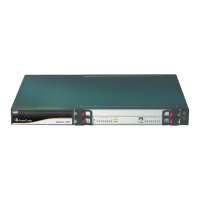User's Manual 960 Document #: LTRT-89730
Mediant 3000
Parameter Description
PremiumServiceClassMediaDiffServ or as defined in IP Profiles per call.
RTP DSCP for MLPP
Immediate
[MLPPImmediateRTPDSC
P]
Defines the RTP DSCP for MLPP Immediate precedence call level.
The valid range is -1 to 63. The default is -1.
Note: If set to -1, the DiffServ value is taken from the global parameter
PremiumServiceClassMediaDiffServ or as defined in IP Profiles per call.
RTP DSCP for MLPP
Flash
[MLPPFlashRTPDSCP]
Defines the RTP DSCP for MLPP Flash precedence call level.
The valid range is -1 to 63. The default is -1.
Note: If set to -1, the DiffServ value is taken from the global parameter
PremiumServiceClassMediaDiffServ or as defined in IP Profiles per call.
RTP DSCP for MLPP
Flash Override
[MLPPFlashOverRTPDSC
P]
Defines the RTP DSCP for MLPP Flash-Override precedence call level.
The valid range is -1 to 63. The default is -1.
Note: If set to -1, the DiffServ value is taken from the global parameter
PremiumServiceClassMediaDiffServ or as defined in IP Profiles per call.
RTP DSCP for MLPP
Flash-Override-Override
[MLPPFlashOverOverRTP
DSCP]
Defines the RTP DSCP for MLPP Flash-Override-Override precedence
call level.
The valid range is -1 to 63. The default is -1.
Note: If set to -1, the DiffServ value is taken from the global parameter
PremiumServiceClassMediaDiffServ or as defined in IP Profiles per call.
58.10.5.7 Call Cut-Through Parameters
The call cut-through parameters are described in the table below.
Table 58-51: Call Cut-Through Parameters
Parameter Description
[DigitalCutThrough]
Enables PSTN CAS channels/endpoints to receive incoming IP calls even
if the B-channels are in off-hook state.
[0] Disabled (default)
[1] Enabled
When enabled, this feature operates as follows:
1 A Tel-to-IP call is established (connected) by the device for a B-
channel.
2 The device receives a SIP BYE (i.e., IP side ends the call) and plays a
reorder tone to the PSTN side for the duration set by the
CutThroughTimeForReOrderTone parameter. The device releases the
call towards the IP side (sends a SIP 200 OK).
3 The PSTN side, for whatever reason, remains off-hook.
4 If a new IP call is received for this B-channel after the reorder tone has
ended, the device “cuts through” the channel and connects the call
immediately (despite the B-channel being in physical off-hook state)
without playing a ring tone. If an IP call is received while the reorder
tone is played, the device rejects the call.
Notes:
If the parameter is disabled and the PSTN side remains in off-hook
state after the IP call ends the call, the device releases the call after 60

